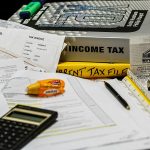Two Mistakes You`re Making with Director`s Loan Account (DLA)
Two Mistakes You`re Making with Director`s Loan Account (DLA)
Nowadays, we are increasingly noticing that many company director clients are making mistakes in the running of their Director`s Loan Account (DLA) and not realising the consequences of getting it wrong. If DLA is not used correctly you could be faced with a large tax bill for yourself and your company. Mistakes occur because many directors treat the money in the company`s bank account as theirs to do with as they wish. Directors sometimes withdraw monies from the company, sometimes pay money into their company bank account or pay their personal expenses from the company bank account. All these transactions should go through the Director`s Loan Account (DLA).
Now we will focus on the two most common mistakes that director`s make, the consequences of these mistakes and how to make sure that they don’t happen.
Mistake One:
The company has applied for a loan. Most recently such loans are likely to have been the Bounce Back Loan Scheme (BBLS) or the Coronavirus Business Interruption Loan Scheme (CBILS). The mistake is that the director spends the money on personal expenses rather than for the business itself. By doing this the director has effectively “borrowed” money from the company and this borrowing needs to be reflected in the DLA. Not returning this money will leave the company (and possibly the director) with a very large tax bill.
For example, Bounce Back Loan is received by your company and the monies placed in the company bank account. You then transfer an amount into your private bank account. If this amount is not repaid within nine months and one day of the company`s accounting year end then your company will be left with a tax bill of 32.5% of the amount taken called a “Section 455” Tax Charge. *1
For example, let`s say your limited company`s year-end date is 31st December 2020. Corporation Tax is due nine months and one day after that date. Therefore, the corporation tax payment will be due on 01st October 2021.
The company received a Bounce Back Loan of £10,000 on 1st May 2020 and you pay this amount into your bank private account for your personal use. If this amount is not repaid by 01st October 2021 then there will be a tax charge of £3,250 (£10,000 x 32.5% = £3,250) on the company.
In addition, if the loan amount exceeds £10,000 at any time during the year then as a director you may also be liable to pay tax on the benefit in kind received if you do not pay interest at the going rate. We call this a “P11D benefit in kind” charge as you get the benefit of using this money at a Nil rate of interest. This “benefit” will have to be declared on your self-assessment tax return. *2

Mistake Two:
Another very important mistake we are going to focus on is Dividend withdrawal. Imagine the company has received £90,000 in income during its accounting year and the expenses total £60,000. The company will pay 19% in Corporation tax on the net profit which is £30,000 x 19% = £5,700 tax.
Deducting the expenses and the tax bill from the income will results in a profit of £24,300 after tax.
However, sometimes we would notice that instead of £24,300, the director withdraws a higher amount of say £35,000 as a Dividend and there aren`t brought forward retained earnings (reserves) available in the company.
In the example, the director has taken £10,700 more than he should (£35,000 – £24,300 = £10,700) from the business and this has resulted in an overdrawn DLA. The overdrawn amount will trigger the S455 tax on the company if it is not paid back to the business within nine months and one day of the company`s accounting year-end as explained above under mistakes one.
A few important extra points:
- Section 455 tax is repayable. If you repay the loan within the time limit then this amount can be reclaimed from HMRC. You have 4 years and six months after your company pays Section 455 tax to reclaim this tax amount. Of course, to claim this tax you have to pay the loan amount back to the company first.
- Section 455 tax rule is the same for shareholders even if they are not directors of the close company.
- A P11d form will need to be submitted to HMRC. Your accountant can do that for you using their payroll software.
- Section 455 tax came into force with Corporation Tax Act 2010. You can find further details within the legislation. *3
How to avoid these charges?
The best way to avoid these charges is by having good communications with your accountant. A good accountant will use the latest accounting software thereby allowing you to log into your accounts and follow your director loan transactions. This way you can keep on top of things and avoid the S455 tax charges and possible P11d benefit in kind charges.
We at “Accountancy Assist Ltd” use the latest digital software, our systems are very transparent. Our clients can find it very easy to follow their transactions, payments, creditors, debtors and director`s loan accounts entries.
If you would like us to show you how to contact us.
MK-2020.11
*1 https://www.gov.uk/hmrc-internal-manuals/company-taxation-manual/ctm61505
*2 https://www.gov.uk/expenses-and-benefits-loans-provided-to-employees
*3 https://www.legislation.gov.uk/ukpga/2010/4/section/455






